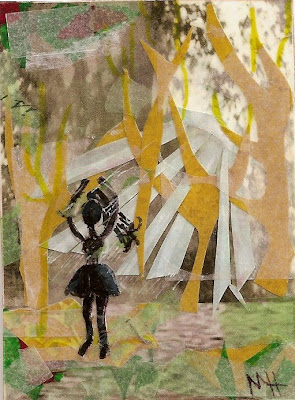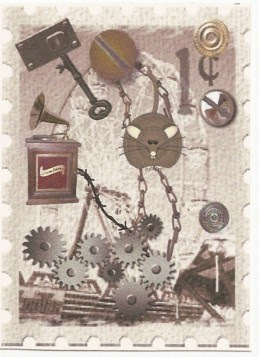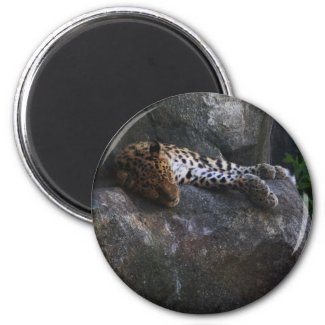
"Dancing In The Moonlight"
I have always been confused as to the difference between a collage and a montage. So...today I thought I would look up the definitions of both of those terms and share them here for anyone else that may be confused like moi.
From Wikipedia, the free encyclopediaA collage (From the French: coller, to glue) is a work of formal art, primarily in the visual arts, made from an assemblage of different forms, thus creating a new whole.
A collage may include newspaper clippings, ribbons, bits of colored or hand-made papers, portions of other artwork, photographs, a piece of moss or even a dead mole and other found objects, glued to a piece of paper or canvas. The origins of collage can be traced back hundreds of years, but this technique made a dramatic reappearance in the early 20th century as an art form of novelty.
The term collage derives from the French "coller" meaning "glue".[1] This term was coined by both Georges Braque and Pablo Picasso in the beginning of the 20th century when collage became a distinctive part of modern art.
Montage (from the French for "putting together") most often refers to collage including photomontage and sound collage.
Photomontage are Collage made from photographs, or parts of photographs. Photomontage is the process (and result) of making a composite photograph by cutting and joining a number of other photographs. The composite picture was sometimes photographed so that the final image is converted back into a seamless photographic print. The same method is accomplished today using image-editing software. The technique is referred to by professionals as compositing.
Other methods for combining pictures are also called photomontage, such as Victorian "combination printing", the printing from more than one negative on a single piece of printing paper (e.g. O. G. Rejlander, 1857), front-projection and computer montage techniques. Much as a collage is composed of multiple facets, artists also combine montage techniques. Romare Bearden’s (1912–1988) series of black and white "photomontage projections" is an example. His method began with compositions of paper, paint, and photographs put on boards 8½ × 11 inches. Bearden fixed the imagery with an emulsion that he then applied with handroller. Subsequently, he enlarged the collages photographically.
The 19th century tradition of physically joining multiple images into a composite and photographing the results prevailed in press photography and offset lithography until the widespread use of digital image editing. Contemporary photo editors in magazines now create "paste-ups" digitally.
Creating a photomontage has, for the most part, become easier with the advent of computer software such as Adobe Photoshop, Pixel image editor, and GIMP. These programs make the changes digitally, allowing for faster workflow and more precise results. They also mitigate mistakes by allowing the artist to "undo" errors. Yet some artists are pushing the boundaries of digital image editing to create extremely time-intensive compositions that rival the demands of the traditional arts. The current trend is to create pictures that combine painting, theatre, illustration and graphics in a seamless photographic whole.

"SteamPunk, a digital Collage"
I was still confused and then I found this answer to the question about what the difference between a collage and a montage was and it cleared it up for me:
"A collage is a piece of art made up of many different elements with different texture, colors, etc. They are pasted onto the surface of a board.
A montage is made up of many images that are put together or superimposed and then printed so that all the images form a single unit."









